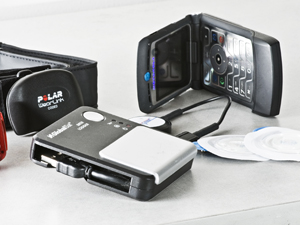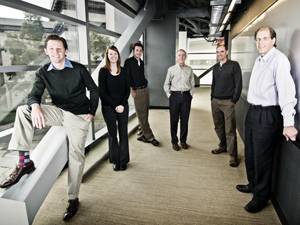Improving Health Through Exercise and Mobile Monitoring
San Diego, Calif., April 23, 2009 — Looking for the secret to a long, healthy life? Chances are, you'll find it in your back pocket.
|
The ubiquitous cell phone is at the center of a novel approach to health behavior research underway at the University of California, San Diego. The initiative — based in the California Institute for Telecommunications and Information Technology (Calit2) and led by Dr. Kevin Patrick, a professor of Family and Preventive Medicine at UC San Diego — aims to develop a series of wireless-based solutions for measuring health behaviors in order to understand how and why disease occurs, and how it might be prevented.
"Our vision is that the mobile phone will become the hub in a 'body area network' — a collection of sensor devices that people wear on their bodies," Patrick explains. "These devices might monitor heart rate, breathing, physical activity and even dietary intake.
"But in addition to monitoring the status of an individual at a given time," he continues, "we also want to analyze that information and turn it around in real time so that it can prompt a change in behavior."
While remaining on the School of Medicine faculty, Patrick approached Calit2's division director at UC San Diego, Ramesh Rao, and last fall, he moved his large and growing research team into Atkinson Hall. He now directs the Calit2-based Center for Wireless and Population Health Systems (CWPHS), which he dubs a "clinical outpost" of the School of Medicine — an outpost that is uniquely situated to take advantage of the unrivaled wireless expertise at Calit2 and the Jacobs School of Engineering. CWPHS is also well positioned to participate in UC San Diego's newly created Institute of Engineering in Medicine (IEM), which counts Patrick as a member.
"Physical activity is a vital part of daily life. It applies to everyone," Patrick notes. "We've known since the late 1980s that an absence of physical activity has deleterious health effects on individuals and populations, but we've engineered much of that activity out of our daily existence as we've become a civilized, sedentary society. What we need to do is improve the ability of individuals to develop and sustain improved health behaviors. With the mobile phone and ubiquitous computing, we can now deliver tailored and just-in-time messages designed to promote improved activity-related behaviors to individuals anytime, anywhere."
CWPHS consists of more than 30 professionals with expertise in healthcare and medicine, psychology, computer sciences, media technology and numerous other fields. They work in interdisciplinary teams to develop tools that health care providers, health care systems and individuals can use to improve health outcomes.
|
Patrick's early research — initially funded by the U.S. Centers for Disease Control and Prevention, and more recently by the National Institutes of Health (NIH) — focused on the development of tools that physicians could use to motivate their patients to become and stay physically active. After initially recommending paper-based materials to encourage clinicians to have conversations about physical activity and healthy diets with their patients, Patrick's team eventually gravitated to the Web and, more recently, mobile-based approaches.
This research has now evolved into a broad set of activities and capabilities, including two of the largest: the Physical Activity and Location Measurement System (PALMS), and EPARC — the Exercise and Physical Activity Resource Center.
PALMS: Sensor-based Cyberinfrastructure for Health Monitoring
As the researchers in Patrick's group delve more deeply into the promotion of physical activity, they have also begun researching how better to measure the complicated behavior in individuals and populations. Advances in our understanding of the human genome and in exposure-biology research have raised several questions about the role physical activity might play in the development of disease.
"While great progress is being made in genomics and proteomics, we lag far behind in our ability to precisely measure physical activity in free living humans." Patrick says. One such approach is PALMS, a research project funded by the NIH and coordinated under the Gene Environment Initiative. PALMS incorporates a suite of wearable sensors that measure physical activity (e.g., accelerometers and heart rate/motion sensors), physical location (GPS) sensors and, if a researcher desires, environmental parameters (air quality) to detect patterns in physical activity within the context of a specific environment.
At this point the sensors capture and store their data for subsequent download and analysis. But Patrick's vision is that future versions of PALMS and related technologies would communicate wirelessly with the individual's mobile phone, which then would interface with a custom cyberinfrastructure designed by UC San Diego computer science professors Ingolf Krueger and William Griswold, along with one of their Ph.D. students, Barry Demchak, and Fred Raab of the CWPHS. Krueger and Griswold are both long-time participants in Calit2, where Krueger runs the Software and Systems Architecture & Integration Team (SAINT).
|
"Traditionally, scientists have measured environmental contaminants by having scattered devices stuck in the ground somewhere, and somehow it's up to the individual to infer what's going on in his or her personal space," explains Patrick. "It's a very new science, this notion of synthesizing behavioral data with concurrently collected, geo-located data."
Once the PALMS data has been aggregated, researchers in the "exposure biology" community can manipulate the PALMS user interface (created by CWPHS/Calit2 programmer Alline Watkins) to create visual models depicting where a subject was geographically when his heart rate went up, for example, or when his pace slowed. This integrated means of data gathering gives scientists and health practitioners a much better understanding of the way terrain (such as a very steep hill) or environmental factors (such as smog) can impact an individual's physical activity. "The PALMS cyberinfrastructure is a complete system, from end to end," says Demchak. "What that means is that investigators can define a study, add data, store data, calculate based on data and visualize the results."
Demchak points out that another important benefit of the cyberinfrastructure (CI) is that it encourages community participation by serving as a clearinghouse for resources that researchers can share among themselves.
"Cyberinfrastructures are all about community," Demchak says. "You can imagine our CI for the exposure biology community federating with a CI created by the cancer community, enabling them to conduct more comprehensive studies and draw more accurate conclusions, more cheaply."
"Over time," adds Patrick, "you would get an understanding of what's happening not only within the context of a certain area, but what's happening right down to an individual level."
Eventually, Patrick and his team hope to bring the PALMS system full-circle, so that a person with a heart condition might receive a warning to reduce the intensity of his or her workout because of poor air quality or an upcoming change in terrain. The idea might also extend into the realm of disaster management, Demchak says, or other large-scale, interactive endeavors that use mobile phones as sensor devices.
EPARC: A Resource for Researchers
The move of Patrick's research team to Calit2 in late 2008 offered additional space to house an Exercise and Physical Activity Resource Center, a new resource for researchers at UC San Diego and the broader life-sciences community of San Diego. As with the PALMS project, Patrick notes that the need for EPARC became evident over the years.
"Researchers in disciplines such as psychiatry and pediatrics were becoming aware of the importance of accurate measurement of physical activity behaviors in their research but lacked the expertise to address it themselves. We were getting more and more requests for informal consultation or to borrow accelerometers," says Patrick. "We needed to find a way to structure our responses so that all parties were satisfied."
Located on the third floor of Calit2's Atkinson Hall, EPARC offers researchers a menu of consultation services, including the temporary use of sensors such as heart rate monitors, accelerometers, GPS devices and other tools to measure physical activity and related physiological parameters. The software underlying the use of these sensors is becoming increasingly sophisticated and EPARC staff members have found that researchers value this expertise as well. EPARC now has plans to let faculty and other researchers do clinical evaluations of sensors on site in their lab. The aim is for EPARC to be a setting in which a combination of exercise science, health behavior, medical and human-device interface expertise can come together to enable the development of prototypes much more quickly than might occur otherwise.
"It's a non-trivial issue to develop a sensor for physical activity that's easy to use, has a long battery life, communicates with a high level of fidelity with one's mobile phone and is of reasonable cost," Patrick says. "Yet the demand for these sorts of devices will only increase with time, and there is an enormous upside to being able to test them in a high-quality lab environment like Calit2."
Related Links
Exercise and Physical Activity Resource Center (EPARC)
UC San Diego School of Medicine
UC San Diego Jacobs School of Engineering
Institute of Engineering in Medicine
Calit2's Software and Systems Architecture & Integration Team (SAINT)
Media Contacts
Tiffany Fox, (858) 246-0353, tfox@ucsd.edu



